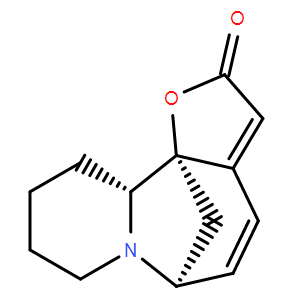| Cas No.: | 5610-40-2 |
| SMILES: | O=C(O1)C=C2[C@@]13[C@](CCCC4)([H])N4[C@](C3)([H])C=C2 |
| Formula: | C13H15NO2 |
| M.Wt: | 217.26 |
| Sotrage: | 4°C for 1 year, -20°C for more than 2 years |
| Description: | (-)-Securinine is plant-derived alkaloid and also a GABAA receptor antagonist. |
| In Vivo: | In this tumor model, tumor growth is significantly impaired with (-)-Securinine treatment indicating that (-)-Securinine has potential as an Acute Myeloid Leukemia (AML) therapeutic. (-)-Securinine treated mice (n=5 mice, bilateral tumors), exhibit an average of more than 75% smaller tumors than vehicle treated mice at the end of the study period[2]. |
| In Vitro: | (-)-Securinine is a major plant-derived alkaloid and also a GABAA receptor antagonist. (-)-Securinine is significantly potent on HeLa cells growth inhibition with IC50 values of 7.02±0.52 μg/mL (32.3 μM). (-)-Securinine induces apoptosis in a dose-dependent manner in the tested cells, increases the percentage of ROS positive cells and depolarized cells as well as stimulates the activity of ERK1/2, caspase-9 and -3/7. (-)-Securinine also induces cell cycle arrest in S phase. Real-time PCR analysis shows high expression of tumor necrosis factor receptor superfamily (TNFRSF) genes in the cells stimulated with (-)-Securinine[1]. |

 DC Chemicals' products qualify for U.S. tariff exemptions. We guarantee no price increases due to customs duties and maintain stable supply, continuing to deliver reliable research solutions to our American clients.
DC Chemicals' products qualify for U.S. tariff exemptions. We guarantee no price increases due to customs duties and maintain stable supply, continuing to deliver reliable research solutions to our American clients.





















